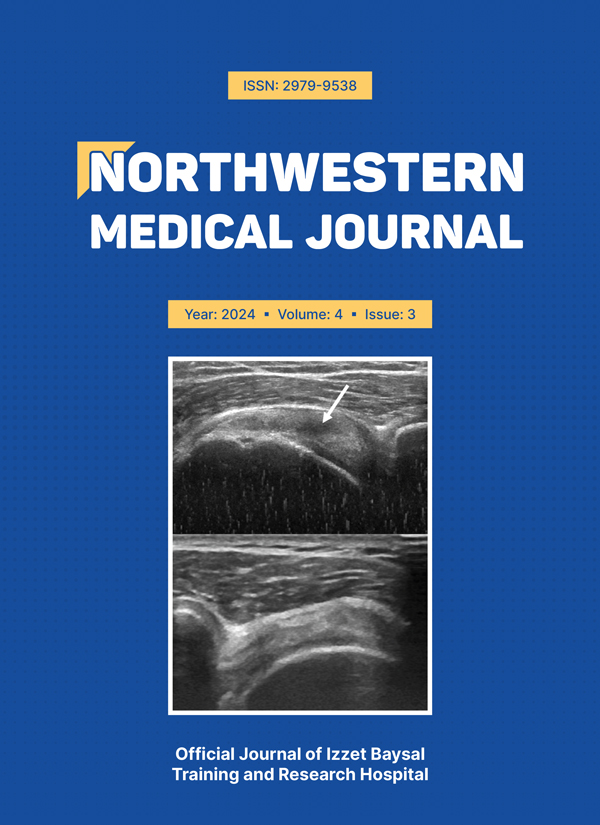Abstract
Aim: Perinatal asphyxia affects whole body systems and depending on compensation mechanisms, the central nervous system is primarily protected. In this study, we aimed to evaluate brain electrophysiological activity in cases with postnatal feeding intolerance due to perinatal asphyxia and to investigate whether the compensation mechanism is adequate or whether there is a minimal electrophysiological disorder.
Methods: This study was conducted prospectively to compare the amplitude electroencephalography (EEG) recordings of 22 patients who were followed up with the diagnosis of feeding intolerance due to perinatal asphyxia and 10 control groups. Eeg probes were applied by gluing. Conventional EEG was performed in the patient group and the recordings were evaluated with an amplitude integrated electroencephalography (aEEG). It was also compared with feeding time, length of hospital stay, maternal ages, cord blood gas pH and base deficit values, electrolyte values at the 24th hour, appearance pulse grimace activity and respiration (APGAR) and Burdjalov scores.
Results: When aEEG Vmin values, Burdjalov scores, and 1st min APGAR scores were compared, statistically significant difference was found between the patient and control groups. There was an inverse weak correlation between the patients' aEEG Vmin values and their length of hospital stay. A weak correlation was found between the cases’ cord blood gas base deficit and aEEG Vmax values. When cases were divided into two groups as less than 7 days of hospitalization and more than 7 days of hospitalization, a statistically significant difference was found between the groups in terms of maternal age.
Conclusion: In our study, it was aimed to show whether there is a minimal effect of perinatal asphyxia on EEG findings in newborns with nutritional deficiency. The difference in the aEEG Vmin values of the case and control groups indicates that brain electrical activity is affected. This is also supported by the fact that those with higher Vmin values had shorter hospital stays.
Keywords: aEEG, cEEG, feeding intolerance, perinatal asphyxia
Copyright and license
Copyright © 2024 The Author(s). This is an open-access article published by Bolu İzzet Baysal Training and Research Hospital under the terms of the Creative Commons Attribution License (CC BY) which permits unrestricted use, distribution, and reproduction in any medium or format, provided the original work is properly cited.
How to cite
References
- Miller SP, Latal B, Clark H, et al. Clinical signs predict 30-month neurodevelopmental outcome after neonatal encephalopathy. Am J Obstet Gynecol. 2004; 190(1): 93-9. https://doi.org/10.1016/s0002-9378(03)00908-6
- Shellhaas RA, Soaita AI, Clancy RR. Sensitivity of amplitude-integrated electroencephalography for neonatal seizure detection. Pediatrics. 2007; 120(4): 770-7. https://doi.org/10.1542/peds.2007-0514
- Frenkel N, Friger M, Meledin I, et al. Neonatal seizure recognition--comparative study of continuous-amplitude integrated EEG versus short conventional EEG recordings. Clin Neurophysiol. 2011; 122(6): 1091-7. https://doi.org/10.1016/j.clinph.2010.09.028
- Shany E, Khvatskin S, Golan A, Karplus M. Amplitude-integrated electroencephalography: a tool for monitoring silent seizures in neonates. Pediatr Neurol. 2006; 34(3): 194-9. https://doi.org/10.1016/j.pediatrneurol.2005.06.018
- Mathur AM, Morris LD, Teteh F, Inder TE, Zempel J. Utility of prolonged bedside amplitude-integrated encephalogram in encephalopathic infants. Am J Perinatol. 2008; 25(10): 611-5. https://doi.org/10.1055/s-0028-1090598
- Gluckman PD, Wyatt JS, Azzopardi D, et al. Selective head cooling with mild systemic hypothermia after neonatal encephalopathy: multicentre randomised trial. Lancet. 2005; 365(9460): 663-70. https://doi.org/10.1016/S0140-6736(05)17946-X
- ter Horst HJ, Jongbloed-Pereboom M, van Eykern LA, Bos AF. Amplitude-integrated electroencephalographic activity is suppressed in preterm infants with high scores on illness severity. Early Hum Dev. 2011; 87(5): 385-90. https://doi.org/10.1016/j.earlhumdev.2011.02.006
- Fujikawa DG, Vannucci RC, Dwyer BE, Wasterlain CG. Generalized seizures deplete brain energy reserves in normoxemic newborn monkeys. Brain Res. 1988; 454(1-2): 51-9. https://doi.org/10.1016/0006-8993(88)90802-5
- Toet MC, van der Meij W, de Vries LS, Uiterwaal CSPM, van Huffelen KC. Comparison between simultaneously recorded amplitude integrated electroencephalogram (cerebral function monitor) and standard electroencephalogram in neonates. Pediatrics. 2002; 109(5): 772-9. https://doi.org/10.1542/peds.109.5.772
- Cilio M. EEG and the newborn. J Pediatr Neurol 2015; 7: 25-43. https://doi.org/10.3233/jpn-2009-0272
- Vilan A, de Vries L, Sá-Couto P, et al. PS-155 Comparison of Clinical and Electrophysiological Signs of Encephalopathy In Neonates With Perinatal Asphyxia Qualifying For Hypothermia. Arch Dis Child 2014;99:A167. https://doi.org/10.1136/archdischild-2014-307384.451
- Pichler G, Avian A, Binder C, Zotter H, Schmolzer G, Morris N, et al. 224 aEEG and NIRS During Transition after Birth. Archives of Disease in Childhood. 2012; 97: A64-5. https://doi.org/10.1136/archdischild-2012-302724.0224
- Knutzen L, Svirko E, Impey L. The significance of base deficit in acidemic term neonates. Am J Obstet Gynecol. 2015; 213(3): 373.e1-7. https://doi.org/10.1016/j.ajog.2015.03.051
- Burdjalov VF, Baumgart S, Spitzer AR. Cerebral function monitoring: a new scoring system for the evaluation of brain maturation in neonates. Pediatrics. 2003; 112(4): 855-61. https://doi.org/10.1542/peds.112.4.855
- Topçuoğlu S, Erçin S, Arman D, Gürsoy T, Karatekin G, Ovalı F. Is Adolescent or Advanced Maternal Age Risky for Newborn?: Retrospective Results of a Single Center. Medical Bulletin of Zeynep Kamil. 2014; 45(3): 131-5.
- Kuzma-O'Reilly B, Duenas ML, Greecher C, et al. Evaluation, development, and implementation of potentially better practices in neonatal intensive care nutrition. Pediatrics. 2003; 111(Supplement_E1): e461-70. https://doi.org/10.1542/peds.111.SE1.e461











